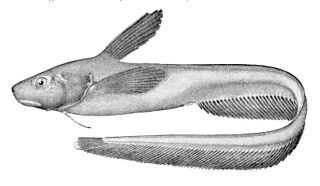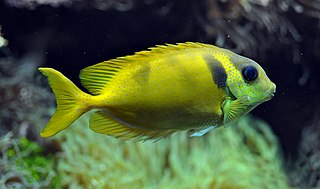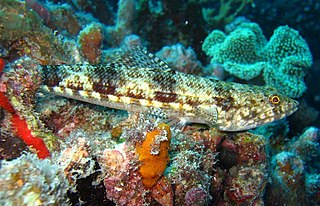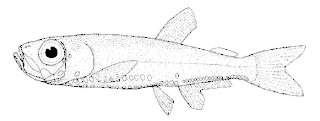
The jellynose fishes or tadpole fishes are the small order Ateleopodiformes. This group of ray-finned fish is monotypic, containing a single family Ateleopodidae. It has about a dozen species in four genera, but these enigmatic fishes are in need of taxonomic revision.

Neopterygii is a subclass of ray-finned fish (Actinopterygii). Neopterygii includes the Holostei and the Teleostei, of which the latter comprise the vast majority of extant fishes, and over half of all living vertebrate species. While living holosteans include only freshwater taxa, teleosts are diverse in both freshwater and marine environments. Many new species of teleosts are scientifically described each year.

Stomiiformes is an order of deep-sea ray-finned fishes of very diverse morphology. It includes, for example, dragonfishes, lightfishes, loosejaws, marine hatchetfishes and viperfishes. The order contains 4 families with more than 50 genera and at least 410 species. As usual for deep-sea fishes, there are few common names for species of the order, but the Stomiiformes as a whole are often called dragonfishes and allies or simply stomiiforms.

Aulopiformes is a diverse order of marine ray-finned fish consisting of some 15 extant and several prehistoric families with about 45 genera and over 230 species. The common names grinners, lizardfishes and allies, or aulopiforms are sometimes used for this group. The scientific name means "Aulopus-shaped", from Aulopus + the standard fish order suffix "-formes". It ultimately derives from Ancient Greek aulós + Latin forma, the former in reference to the elongated shape of many aulopiforms.

Marine hatchetfishes or deep-sea hatchetfishes are small deep-sea mesopelagic ray-finned fish of the stomiiform subfamily Sternoptychinae. They should not be confused with the freshwater hatchetfishes, which are not particularly closely related Teleostei in the characiform family Gasteropelecidae.
Hatchetfish may refer to three groups of fishes:

The Myctophiformes are an order of ray-finned fishes consisting of two families of deep-sea marine fish, most notably the highly abundant lanternfishes (Myctophidae). The blackchins (Neoscopelidae) contain six species in three genera, while the bulk of the family belongs to the Myctophidae, with over 30 genera and some 252 species.

The Gonostomatidae are a family of mesopelagic marine fish, commonly named bristlemouths, lightfishes, or anglemouths. It is a relatively small family, containing only eight known genera and 32 species. However, bristlemouths make up for their lack of diversity with relative abundance, numbering in the hundreds of trillions to quadrillions. The genus Cyclothone is thought to be one of the most abundant vertebrate genera in the world.

Argyropelecus is an oceanic ray-finned fish genus in the deep sea hatchetfish family Sternoptychidae. A collective name is "silver hatchetfishes", but this can also refer to a species of the freshwater hatchetfishes which are not particularly closely related to this. The large pupils of these marine hatchetfishes enable them to see dim objects in the deep sea, where light barely penetrates.

Polyipnus is a genus of oceanic ray-finned fish in the family Sternoptychidae. This is the largest genus of the marine hatchetfishes subfamily Sternoptychinae and indeed of the entire Sternoptychidae. It is not quite as apomorphic as their relatives; it may be that the genus is actually a paraphyletic assemblage of less advanced Sternoptychinae and would need to be split.

Sternoptyx is an oceanic ray-finned fish genus which belongs in the family Sternoptychidae. This is the type genus of the Sternoptychidae, as well as the marine hatchetfish subfamily Sternoptychinae.

Argyripnus is an oceanic ray-finned fish genus in the marine hatchetfish family Sternoptychidae. They are commonly known as bristle-mouth fishes, but that may also refer to the related bristlemouth family (Gonostomatidae). A. iridescens is called "pearlside", which usually refers to the closely related genus Maurolicus.

Maurolicus is an oceanic ray-finned fish genus which belongs in the marine hatchetfish family Sternoptychidae. They are commonly known as pearlsides, but the brilliant pearlside is the related Argyripnus iridescens. Occasionally, "bristle-mouth fishes" is used as a common name, but that usually refers to the genus Argyripnus or the family Gonostomatidae.

Argyropelecus hemigymnus, the half-naked hatchetfish, short silver hatchetfish or spurred hatchetfish, is a deep-sea hatchetfish of the genus Argyropelecus found mesopelagically in the Atlantic, Indian, and Pacific Oceans as well as in the Mediterranean Sea. It is a small species rarely exceeding 38 millimetres (1.5 in) standard length. It feeds on zooplankton, particularly ostracods and copepods. Sexual maturation occurs at length of about 22 mm, and adult males have more developed olfactory organs than females, i.e. the species is sexually dimorphic.

Maurolicus muelleri, commonly referred to as Mueller's pearlside,Mueller's bristle-mouth fish, or the silvery lightfish, is a marine hatchetfish in the genus Maurolicus, found in deep tropical, subtropical and temperate waters of the Pacific Ocean and the Atlantic Ocean, from the surface to depths of 1,500 metres (4,900 ft). It can grow to a maximum total length of 8 centimetres (3.1 in).

The Argentiniformes is an order of marine ray-finned fish whose distinctness was recognized only fairly recently. In former times, they were included in the Osmeriformes as suborder Argentinoidei. That term refers only to the suborder of marine smelts and barreleyes in the classification used here, with the slickheads and allies being the Alepocephaloidei. These suborders were treated as superfamilies Argentinoidea and Alepocephaloidea, respectively, when the present group was still included in the Osmeriformes.

Argyropelecus aculeatus, the lovely hatchetfish or Atlantic silver hatchetfish, is a species of fish in the family Sternoptychidae. It may exceed 70 millimetres (2.8 in) standard length (SL). It lives in the mesopelagic zone of all oceans and performs diel vertical migration. A. aculeatus feeds on a large range of prey items; in the Gulf of Mexico ostracods and copepods dominated the diet of small individuals and euphausiids, molluscs, and fish the diet of larger ones. The silvery coloration and bioluminescence of the lovely hatchetfish allows it to hide from predators and prey in the down-welling light of the twilight zone.

Argyropelecus sladeni, or Sladen's hatchetfish, is a species of ray-finned fish in the family Sternoptychidae, found in the tropical and subtropical Atlantic, Indian and Pacific Oceans. This small fish lives in the mesopelagic zone by day and makes a daily vertical migration to the epipelagic zone at night.

Sternoptyx diaphana, the diaphanous hatchetfish, is a species of deep sea ray-finned fish in the family Sternoptychidae. It is the type species of the genus Sternoptyx, and was first described by the French naturalist Johann Hermann in Der Naturforscher 1781.

Stomiati is a group of teleost fish belonging to the cohort (group) Euteleostei, which is a group of bony fishes within the infra-class Teleostei that evolved ~240 million years ago. Teleostei is a group of ray-finned fishes with the exception of primitive bichirs, sturgeons, paddlefishes, freshwater garfishes, and bowfins. The cohort of Euteleostei is divided into two smaller groups: the Protacanthopterygii and the Neoteleostei. Stomiati happen to be descendants of the Protacanthopterygii, and contains the order of Osmeriformes and Stomiiformes.




















